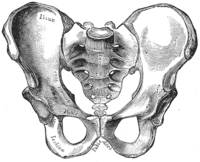
Photo from wikipedia
Introduction and hypothesis This study was aimed at comparing pelvic floor parameters between the standing and supine positions using upright computed tomography (CT) and evaluating the effects of sex and… Click to show full abstract
Introduction and hypothesis This study was aimed at comparing pelvic floor parameters between the standing and supine positions using upright computed tomography (CT) and evaluating the effects of sex and age in normal healthy volunteers. Methods In total, 139 volunteers (70 men, mean 46.7 years; 69 women, mean 47.3 years) underwent both upright CT in the standing position and conventional CT in the supine position. The distances from the bladder neck to the pubococcygeal line (PCL) and anorectal junction (ARJ), defined as the posterior aspect of the puborectalis muscle, to PCL were measured. The length, width, and area of the levator hiatus (LH) were measured on oblique axial images. Results The bladder neck (men, 22.2 ± 4.9 mm vs 28.3 ± 5.3 mm; women, 9.0 ± 5.1 mm vs 19.0 ± 4.0 mm) and ARJ (men, −18.8 ± 5.5 mm vs −12.1 ± 5.1 mm; women, −20.0 ± 4.7 mm vs −11.2 ± 4.3 mm) were significantly lower in the standing position than in the supine position (all p < 0.0001). The LH area (men, 1,990 ± 380 mm 2 vs 1,697 ± 329 mm 2 ; women, 2,284 ± 344 mm 2 vs 1,811 ± 261 mm 2 ) was significantly larger in the standing position (both p < 0.0001). Differences in all parameters between the standing and supine positions were larger in women than in men. ARJ in women showed a significant tendency to descend with age only in the standing position ( r = −0.29, p = 0.017). Conclusions The bladder neck and ARJ descend and the LH area enlarges in the standing position. Pelvic floor mobility is greater in women than in men. Descent of the ARJ in the standing position is associated with aging in women.
Journal Title: International Urogynecology Journal
Year Published: 2020
Link to full text (if available)
Share on Social Media: Sign Up to like & get
recommendations!